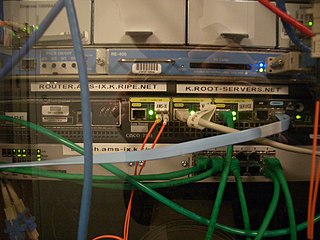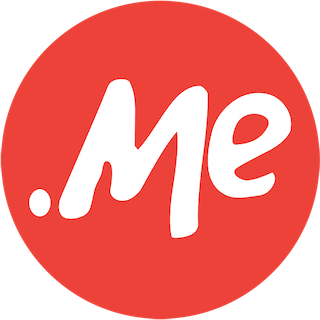A top-level domain (TLD) is one of the domains at the highest level in the hierarchical Domain Name System of the Internet after the root domain. The top-level domain names are installed in the root zone of the name space. For all domains in lower levels, it is the last part of the domain name, that is, the last non-empty label of a fully qualified domain name. For example, in the domain name www.example.com, the top-level domain is .com. Responsibility for management of most top-level domains is delegated to specific organizations by the ICANN, an Internet multi-stakeholder community, which operates the Internet Assigned Numbers Authority (IANA), and is in charge of maintaining the DNS root zone.

In the Internet, a domain name is a string that identifies a realm of administrative autonomy, authority or control. Domain names are often used to identify services provided through the Internet, such as websites, email services and more. Domain names are used in various networking contexts and for application-specific naming and addressing purposes. In general, a domain name identifies a network domain or an Internet Protocol (IP) resource, such as a personal computer used to access the Internet, or a server computer.

A root name server is a name server for the root zone of the Domain Name System (DNS) of the Internet. It directly answers requests for records in the root zone and answers other requests by returning a list of the authoritative name servers for the appropriate top-level domain (TLD). The root name servers are a critical part of the Internet infrastructure because they are the first step in resolving human-readable host names into IP addresses that are used in communication between Internet hosts.

The domain name .tv is the Internet country code top-level domain (ccTLD) for Tuvalu.
Blogger is an American online content management system founded in 1999 which enables its users to write blogs with time-stamped entries. Pyra Labs developed it before being acquired by Google in 2003. Google hosts the blogs, which can be accessed through a subdomain of blogspot.com. Blogs can also be accessed from a user-owned custom domain by using DNS facilities to direct a domain to Google's servers. A user can have up to 100 blogs or websites per account.
A country code top-level domain (ccTLD) is an Internet top-level domain generally used or reserved for a country, sovereign state, or dependent territory identified with a country code. All ASCII ccTLD identifiers are two letters long, and all two-letter top-level domains are ccTLDs.

On the Internet, .cc is the country code top-level domain (ccTLD) for the Cocos (Keeling) Islands, an Australian territory. It is administered by a United States company, VeriSign, through a subsidiary company, eNIC, which promotes it for international registration as "the next .com". The .cc domain was originally assigned to eNIC in October 1997 by the IANA; eNIC manages the TLD alongside SamsDirect Internet.
Generic top-level domains (gTLDs) are one of the categories of top-level domains (TLDs) maintained by the Internet Assigned Numbers Authority (IANA) for use in the Domain Name System of the Internet. A top-level domain is the last level of every fully qualified domain name. They are called generic for historical reasons; initially, they were contrasted with country-specific TLDs in RFC 920.

.co is the Internet country code top-level domain (ccTLD) assigned to Colombia.

The Internet country code top-level domain (ccTLD) .io is nominally assigned to the British Indian Ocean Territory. The domain is managed by Internet Computer Bureau Ltd, a domain name registry, with registrar services provided by Name.com.

The domain name mobi is a generic top-level domain (gTLD) in the Domain Name System (DNS) of the Internet. Its name is derived from the adjective mobile.
URL shortening is a technique on the World Wide Web in which a Uniform Resource Locator (URL) may be made substantially shorter and still direct to the required page. This is achieved by using a redirect which links to the web page that has a long URL. For example, the URL "https://en.wikipedia.org/wiki/URL_shortening" can be shortened to "https://w.wiki/U". Often the redirect domain name is shorter than the original one. A friendly URL may be desired for messaging technologies that limit the number of characters in a message, for reducing the amount of typing required if the reader is copying a URL from a print source, for making it easier for a person to remember, or for the intention of a permalink. In November 2009, the shortened links of the URL shortening service Bitly were accessed 2.1 billion times.

.me is the Internet country code top-level domain (ccTLD) for Montenegro.
The Domain Name System of the Internet consists of a set of top-level domains that constitute the root domain of the hierarchical name space and database. In the growth of the Internet, it became desirable to expand the initial set of six generic top-level domains in 1984. As a result, new top-level domain names have been proposed for implementation by ICANN. Such proposals included a variety of models ranging from adoption of policies for unrestricted gTLDs that could be registered by anyone for any purpose, to chartered gTLDs for specialized uses by specialized organizations. In October 2000, ICANN published a list of proposals for top-level domain strings it had received.
HTTP Strict Transport Security (HSTS) is a policy mechanism that helps to protect websites against man-in-the-middle attacks such as protocol downgrade attacks and cookie hijacking. It allows web servers to declare that web browsers should automatically interact with it using only HTTPS connections, which provide Transport Layer Security (TLS/SSL), unlike the insecure HTTP used alone. HSTS is an IETF standards track protocol and is specified in RFC 6797.

Top Level Design is a company in the United States, and the domain name registry for the generic top-level domains .wiki, .ink, and .gay. Ray King serves as its chief executive officer.

.app is a generic top-level domain (gTLD) in ICANN's New gTLD Program. Google purchased the gTLD in an ICANN Auction of Last Resort in February 2015.

.Tech is a generic top-level domain (gTLD) of the Domain Name System (DNS) used in the Internet. The name is truncated from technology.

.bank is a sponsored top-level domain used in the Domain Name System of the internet. The TLD was officially delegated to fTLD Registry Services on behalf of the Financial Services Roundtable and American Bankers Association on January 5, 2015.












